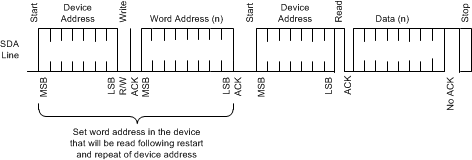JAJSFL5D April 2016 – June 2018 LMH1219
PRODUCTION DATA.
- 1 特長
- 2 アプリケーション
- 3 概要
- 4 改訂履歴
- 5 概要(続き)
- 6 Pin Configuration and Functions
- 7 Specifications
-
8 Detailed Description
- 8.1 Overview
- 8.2 Functional Block Diagram
- 8.3
Feature Description
- 8.3.1 4-Level Input Configuration Pins
- 8.3.2 Input Carrier Detect
- 8.3.3 -6 dB Splitter Mode Launch Amplitude for IN0
- 8.3.4 Continuous Time Linear Equalizer (CTLE)
- 8.3.5 Input-Output Mux Selection
- 8.3.6 Clock and Data Recovery (CDR) Reclocker
- 8.3.7 Internal Eye Opening Monitor (EOM)
- 8.3.8 Output Function Control
- 8.3.9 Output Driver Amplitude and De-Emphasis Control
- 8.3.10 Status Indicators and Interrupts
- 8.3.11 Additional Programmability
- 8.4 Device Functional Modes
- 8.5 LMH1219 Register Map
- 9 Application and Implementation
- 10Power Supply Recommendations
- 11Layout
- 12デバイスおよびドキュメントのサポート
- 13メカニカル、パッケージ、および注文情報
パッケージ・オプション
メカニカル・データ(パッケージ|ピン)
- RTW|24
サーマルパッド・メカニカル・データ
- RTW|24
発注情報
8.4.1.1.2 SMBus Read Operation Format
Reading data from a slave device consists of four parts, as illustrated in Figure 17:
- The master begins with a start condition, followed by the slave device address with the R/W bit set to 0'b.
- After an ACK from the slave device, the 8-bit register word address is written.
- After an ACK from the slave device, the master initiates a re-start condition, followed by the slave address with the R/W bit set to 1'b.
- After an ACK from the slave device, the 8-bit data is read back. The last ACK is high if there are no more bytes to read, and the last read is followed by a stop condition.
 Figure 17. SMBus Read Operation
Figure 17. SMBus Read Operation